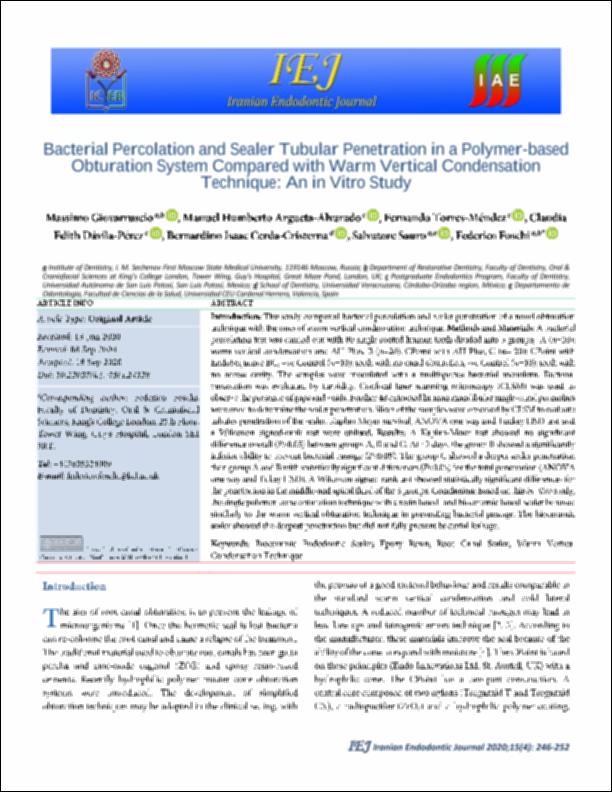Please use this identifier to cite or link to this item:
http://hdl.handle.net/10637/12869Bacterial percolation and sealer tubular penetration in a polymer-based obturation system compared with warm vertical condensation technique : an in vitro study
| Title: | Bacterial percolation and sealer tubular penetration in a polymer-based obturation system compared with warm vertical condensation technique : an in vitro study |
| Authors : | Giovarruscio, Massimo Argueta Alvarado, Manuel Humberto Torres Méndez, Fernando Dávila Pérez, Claudia Edith Cerda Cristerna, Bernardino Isaac Sauro, Salvatore. Foschi, Federico |
| Keywords: | Dental materials.; Teeth - Roots - Planing.; Gomas y resinas - Aplicaciones en Odontología.; Dental adhesives.; Dientes - Cavidades - Preparación.; Materiales dentales.; Adhesivos dentales.; Gums and resins in Dentistry. |
| Publisher: | Iranian Center for Endodontic Research (ICER). |
| Citation: | Giovarruscio, M., Argueta-Alvarado , M. H., Torres-Méndez , F., Dávila-Pérez , C. E., Cerda-Cristerna , B. I., Sauro , S. et al. (2020). Bacterial percolation and sealer tubular penetration in a polymer-based obturation system compared with warm vertical condensation technique: an in vitro study. Iranian Endodontic Journal, vol. 15, i. 4 (10 oct.), pp. 246-252. DOI: https://doi.org/10.22037/iej.v15i4.24328 |
| Abstract: | Introduction: This study compared bacterial percolation and sealer penetration of a novel obturation technique with the ones of warm vertical condensation technique. Methods and Materials: A bacterial percolation test was carried out with 80 single rooted human teeth divided into 5 groups; A (n=20): warm vertical condensation and AH-Plus, B (n=20): CPoint with AH-Plus, C (n= 20): CPoint with EndoSequence BC, +ve Control (n=10): teeth with no canal obturation, -ve Control (n=10): teeth with no access cavity. The samples were inoculated with a multispecies bacterial incoulum. Bacterial percolation was evaluated by turbidity. Confocal laser scanning microscopy (CLSM) was used to observe the presence of gaps and voids. Further 48 extracted human mandibular single-canal premolars were used to determine the sealer penetration. Slices of the samples were observed by CLSM to evaluate tubules penetration of the sealer. Kaplan Meyer survival, ANOVA one way and Tuckey HSD test and a Wilcoxon signed-rank test were utilised. Results: A Kaplan-Meier test showed no significant difference overall (P>0.05) between groups A, B and C. At 43 days, the group B showed a significantly inferior ability to prevent bacterial passage (P<0.05). The group C showed a deeper sealer penetration than group A and B with statistically significant differences (P<0.05) for the total penetration (ANOVA one way and Tukey HSD). A Wilcoxon signed-rank test showed statistically significant differences for the penetration in the middle-and apical third of the 3 groups. Conclusion: Based on this in vitro study, the single polymer-cone obturation technique with a resin based- and bioceramic based-sealer behaved similarly to the warm vertical obturation technique in preventing bacterial passage. The bioceramic sealer showed the deepest penetration but did not fully prevent bacterial leakage. |
| Description: | Este artículo se encuentra disponible en la siguiente URL: https://journals.sbmu.ac.ir/iej/article/view/24328/25894 |
| URI: | http://hdl.handle.net/10637/12869 |
| Rights : | http://creativecommons.org/licenses/by-nc-sa/4.0/deed.es |
| ISSN: | 1735-7497 (Electrónico). |
| Issue Date: | 10-Oct-2020 |
| Center : | Universidad Cardenal Herrera-CEU |
| Appears in Collections: | Dpto. Odontología |
Items in DSpace are protected by copyright, with all rights reserved, unless otherwise indicated.


